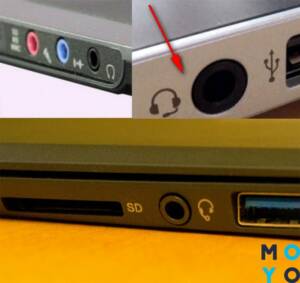- Step 1: Connect a USB microphone to your computer
- Step 2. Select USB microphone in sound settings
- Step 1: Launch Audacity.
- Step 2. Select USB microphone as audio source.
- Step 3: Adjust the microphone volume.
- Step 4: Start recording audio.
- Step 5. Solving problems with a USB microphone: what to do if it doesn’t work
- What sound settings are important for high-quality voice recording on a USB microphone?
Step 1: Connect a USB microphone to your computer
First, you need to connect your USB microphone to your computer correctly. In most cases, this is done very simply - just insert the USB plug into the appropriate port on your computer. However, if you have problems with the microphone being detected, try the following recommendations: 1. Make sure that the microphone's USB plug is inserted into the appropriate port on your computer. It is usually marked with a 'microphone' symbol. 2. Check that the microphone is turned on. Some microphone models have a built-in switch. 3. If your computer does not recognize the microphone, check that the drivers are installed on the device. To do this, go to the 'Devices and Printers' menu and find your microphone in the list of connected devices. If the device is not detected, try restarting your computer. After the microphone is successfully connected to the computer, you can proceed to the next step - setting up the sound.
Step 2. Select USB microphone in sound settings
Once you have connected the USB microphone to your computer, you need to select it as your audio input device in your operating system's audio settings. To do this, follow these steps:
1. Right-click on the speaker icon in the lower right corner of the screen.
2. Select 'Sound Settings' from the context menu.
3. In the window that opens, go to the 'Recording' tab.
4. Make sure the USB microphone is connected to your computer and turned on.
5. Find your USB microphone in the list of devices and left-click on it.
6. Click the 'Set as Default' button to select the USB microphone as your primary audio input device.
7. Adjust the volume level and other microphone settings to your liking.
8. Click 'Apply' and 'OK' to save the settings.
Your USB microphone is now ready to use. When recording audio in a program or application, select it as the audio input device. Also be sure to check the audio for noise and overlap to ensure the best recording results.
After you have connected the USB microphone to your computer, you need to configure it in the audio recording program. In this case we will use the Audacity program.
Step 1: Launch Audacity.
To begin, open Audacity on your computer. If you haven't installed it yet, download and install it from the official website.
Step 2. Select USB microphone as audio source.
Next, you need to select a USB microphone as the audio source. To do this, go to the 'Devices' menu and select 'Record from'. Select your USB microphone from the list.
Step 3: Adjust the microphone volume.
It is important to adjust the microphone volume so that the recording is clear and understandable. To do this, you can use the volume control on the microphone itself or in Audacity. Click on the 'Input Level' button and adjust the volume to the optimal level.
Step 4: Start recording audio.
Once you have configured your microphone in Audacity, you can begin recording audio. Click on the 'Record' button and start speaking into the microphone. After finishing recording, save the file on your computer.
So, with a simple setup in Audacity, you can use a USB microphone to record audio.
Step 5. Solving problems with a USB microphone: what to do if it doesn’t work
If your USB microphone does not work after you connect it to your computer, there are several reasons why this happened. First of all, make sure that the microphone is connected to the correct USB port and that its drivers are installed on your computer.
If you have made sure that the connection and drivers are installed correctly, but the microphone still does not work, try testing it on another computer. If the microphone works on another computer, then the problem is with your computer.
If the microphone does not work on another computer, try replacing the USB cable. Sometimes the cable may be damaged or incompatible with your microphone.
If you've tried all of the above and the microphone still doesn't work, the problem may be with the microphone itself. In this case, contact the manufacturer or retailer for assistance in resolving the problem.
In any case, don't be upset. Solving problems with USB microphones is quite simple, and you can enjoy high-quality sound in your recordings and video conferences. How to choose the right USB microphone for voice recording
A USB microphone is a device that will help you record high-quality sound. It connects to your computer via USB and has excellent audio performance. However, choosing the right USB microphone can be difficult. You need to consider several factors such as price, quality and functionality.
Before choosing a USB microphone, consider what price you are willing to pay. Some models can be quite expensive, but still have high sound quality. Determine your budget and choose a microphone according to it.
Also, pay attention to the characteristics of the microphone. These may include frequency range, sensitivity and impedance. The higher the frequency range and sensitivity, the better the sound. However, the resistance should not be too high, otherwise the microphone will require additional amplification.
Finally, choose a USB microphone according to what you will use it for. If you are recording your voice for a vlog, then you need to choose a microphone with noise reduction function. If you work in a studio, you need a microphone with high sound quality.
Choosing a USB microphone can be difficult, but if you follow these simple tips, you can choose the right microphone for voice recording.
What sound settings are important for high-quality voice recording on a USB microphone?
A USB microphone is a convenient and affordable means of recording voice. However, to get a high-quality recording, you need to set up the sound correctly. Here are some important settings:
1. Sampling frequency. This is the setting that determines how often the audio data is updated during recording. The higher the sampling frequency, the better the audio quality, but the larger the file size. The recommended sampling frequency for voice recording is 44100 Hz.
2. Bitrate. This is a setting that determines the amount of data that will be recorded per second. The higher the bitrate, the better the sound quality, but the larger the file size. The recommended bitrate for voice recording is 128 kbps.
3. Gain level. This setting determines how loud the sound will be recorded. If the gain level is too high, the sound will be distorted. If it is too low, the recording will be too quiet. The recommended gain level for voice recording is from 0 to +6 dB.
4. Noise reduction. This setting allows you to reduce noise during recording. However, too high a noise reduction level may result in loss of sound quality. The recommended noise reduction level for voice recording is from 50% to 70%.
By following these simple recommendations, you can get high-quality voice recording on a USB microphone. To start testing a USB microphone, you need to select a program that will record sound. You can use a standard audio recording tool that is built into the computer operating system, or you can choose a specialized program.
After selecting the program, you need to connect the microphone to the computer. It is recommended to use a USB port as it provides more stable operation of the device.
Next, you need to check the sound settings on your computer and in the recording program. Make sure the correct microphone is selected and the volume levels are set correctly.
Finally, you can start recording the test sound. Read any text into the microphone and evaluate the quality of the recording. When assessing sound quality, it is worth paying attention to the sampling frequency and sensitivity of the microphone.
If the sound is recorded clearly and understandably, then the microphone is working correctly. Otherwise, it might be worth checking your settings or replacing the microphone with a better one.
Don't forget to save the recording and listen to it on another device to ensure the sound quality. To get started with a USB microphone, you need to connect it to your computer. After connecting, the computer should automatically recognize the device and install the necessary drivers. If this does not happen, you can download drivers from the manufacturer's official website.
Then you need to select the USB microphone as the recording device in the audio device settings. To do this, open the control panel and go to the “Sound” section. Then select the "Recording" tab and find your USB microphone in the list of devices. Select it and click the “Set as default device” button.
To test the functionality of the microphone, you can use the audio recording program that comes with your operating system. Launch this program and start recording, speak a few words into the microphone and then stop recording. Play back the recorded audio and check how your microphone sounds.
Now your USB microphone is ready to use with voice chat and streaming programs. Don't forget to adjust the microphone volume level so that your voice is heard clearly and loudly. You can also use special programs to adjust the sound, which can help you get better sound quality. If you encounter problems when using a USB microphone - no sound, noise or other problems, do not despair. In this article, we will tell you how to solve these problems and set up a USB microphone on your computer.
Step 1: Check your connection
First of all, make sure that the USB microphone is properly connected to the computer. Try connecting it to a different USB port or to a different computer to make sure that the problem is not with the microphone itself.
Step 2: Check your audio settings
Open the Audio Control Panel and check the Recording tab settings. Make sure the correct microphone is selected and turned on. If the microphone you need is not in the list, try updating your sound card or microphone drivers.
Step 3: Get rid of noise
If you hear noise while recording audio, try changing the microphone volume in the audio settings. Using a noise filter or connecting the microphone through a power filter may also help.
Step 4: Check for updates
If your USB microphone problem persists, check for updates to your microphone drivers or operating system. Often an update resolves compatibility issues and improves the performance of the device.
By following these simple steps, you can set up a USB microphone and avoid problems during use.
Read further:






